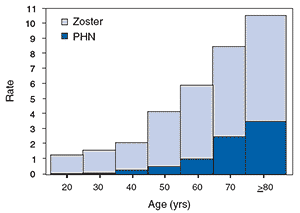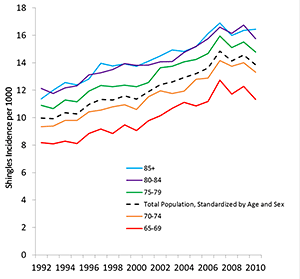Shingles Surveillance
Shingles and Postherpatic Neuralgia† Rates* by Age, United States

*per 1,000 person-years.
† Defined as pain for 30 days or longer
Source: https://www.cdc.gov/mmwr/preview
/mmwrhtml/rr5705a1.htm
Almost 1 out of 3 people in the United States will develop shingles during their lifetime. Most people who get shingles will have it only once. However, it is possible to get it a second or even third time.
Your risk of getting shingles increases as you age, especially after age 50. The most common complication of shingles is postherpatic neuralgia (PHN), which is severe pain in the areas where the shingles rash occurred. About 1 out of 5 people with shingles will get PHN. The risk of PHN increases with age.
Children can get shingles, but it is not common.
Hospitalizations
Approximately 1 to 4% of people who get shingles are hospitalized for complications. Older adults and people with weakened or suppressed immune systems are more likely to be hospitalized. About 30% of people hospitalized for shingles have a weakened or suppressed immune system.
Deaths
Each year, about 96 shingles-related deaths occur in the United States. Almost all the deaths occur in elderly people or those with a weakened or suppressed immune system.
Trends
Shingles Rates in People Older than 65 Years, United States, 1992–2010

Data Source: http://annals.org/article.aspx?articleid=1784289
Shingles is increasing among adults in the United States. The increase has been gradual over a long period of time. We do not know the reason for this increase.
One popular explanation, now thought unlikely, is that the increase in shingles might be related to fewer chickenpox cases in United States children due to widespread vaccination against chickenpox. It is suggested that exposure to chickenpox disease may boost a person’s immunity to the varicella-zoster virus (VZV) and reduce risk for VZV reactivation in the form of shingles. Therefore, less exposure to children with chickenpox could in theory lead to an increase in shingles in adults. However, this proposed explanation seems unlikely based on two CDC studies which found that shingles rates:
- started increasing before chickenpox vaccine was introduced in the United States, and
- did not increase faster after the routine chickenpox vaccination program started.
Other countries without routine chickenpox vaccination programs, have observed similar increases in shingles rates.
Although not common among children, the rate of shingles in United States children has been declining since the routine varicella vaccination program began. Like the wild-type (natural) virus, the attenuated (weakened) vaccine virus can reactivate and cause shingles. However, children who get the chickenpox vaccine appear to have a much lower risk of shingles than children who were infected with wild-type chickenpox. Vaccinated children are less likely to become infected with wild-type chickenpox virus, which is more likely to reactivate as shingles compared to attenuated vaccine virus.
Shingles Vaccination
In 2014, 28% of adults aged 60 years and older reported receiving the shingles vaccine. This is an increase from the 24% reported the previous year.
References
- Hales CM, Harpaz R, Joesoef MR, Bialek SR (2013). Examination of links between herpes zoster incidence and childhood varicella vaccination.Annals of Internal Medicine. 159(11):739-45.
- Weinmann S, Chun C, Schmid DS, Roberts M, Vandermeer M, Riedlinger K, et al. Incidence and clinical characteristics of herpes zoster among children in the varicella vaccine era, 2005–2009.Journal of Infection Diseases. 2013;208(11):1859-68.
- Mahamud A, Marin M, Nickell SP, Shoemaker T, Zhang JX, Bialek SR. Herpes zoster-related deaths in the United States: validity of death certificates and mortality rates, 1979-2007. Clin Infect Dis.2012 Oct;55(7):960-6.
- Leung J, Harpaz R, Molinari NA, Jumaan A, Zhou F. Herpes zoster incidence among insured persons in the United States, 1993-2006: evaluation of impact of varicella vaccination. Clinical Infectious Diseases. 2011;52(3):332-340.
- Jumaan AO, Yu O, Jackson LA, Bohlke K, Galil K, Seward JF. Incidence of herpes zoster, before and after varicella vaccination-associated decreases in the incidence of varicella. Journal of Infectious Diseases. 2005;191:2002-7.
- Brisson M, Edmunds WJ, Law B, et al. Epidemiology of varicella zoster virus infection in Canada and the United Kingdom. Epidemiol Infect 2001;127,305–14.
- Schmader K. Herpes zoster in older adults. Clin Infect Dis 2001;32:1481–6.
- Page last reviewed: August 19, 2016
- Page last updated: August 19, 2016
- Content source:



 ShareCompartir
ShareCompartir